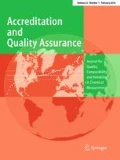Abstract
The importance of the appropriate sample management in regulated bioanalyses is undeniable for clinical and non-clinical study support due to the fact that if samples are compromised at any stage prior to the analysis, the study results may be affected. Therefore, one of the necessary elements of clinical trials (CT) planning following the concept of quality-by-design is the conduct of risk assessment using specific tools, such as risk assessment methods. The purpose of this paper is to analyze the most general concepts of risk assessment and to select the most optimal method for quality management of CT data. The methodological basis of the study is WHO regulation and research papers on risk management. A comparative analysis of the main risk assessment methods has been conducted. Our preference is given to the hazard analysis and critical control points (HACCP) method, a systematic preventive method for CT data quality assurance. The results of the comparison have identified the advantages and disadvantages of the most popular methods of risk assessment and the opportunities of using HACCP systems for quality assurance. Unlike most risk assessment methods, the HACCP methodology uses proactive measures instead of corrective actions, so it is appropriate to use at the clinical trial site.
Availability of data and material
The authors confirm that the data supporting the findings of this study are available within the article and its supplementary materials.
Code availability
Not applicable.
References
ICH E6 (R2), EMA/CHMP / ICH / 135/1995: Guideline for good clinical practice, 30–31. (2017). https://www.ema.europa.eu/en/documents/scientific-guideline/ich-e-6-r2-guideline-good-clinical-practice-step-5_en.pdf
Vaught JB, Henderson MK. (2011). Biological sample collection, processing, storage and information management. IARC Sci Publ. 163:23–42. https://pdfs.semanticscholar.org/32ed/d15bca381c4deb4d71079c2c857ea34e6473.pdf
EMA/INS/GMP/79766/2011 Quality risk management (ICH Q9). (2011)
Guidelines for failure modes and effects analysis (FMEA) for medical devices. (2003). Ontario, Canada. Dyadem Press.
McDermott RE, Mikulak RJ, Beauregard MR. (1996). The basics of FMEA.
Stamatis DH (2003) Failure mode and effect analysis. FMEA from theory to execution, 2nd edn. American Society for Quality, Quality Press, Milwaukee
IEC 61882 - Hazard operability analysis (HAZOP). Geneva, International Electrotechnical Commission, Headquarters (IEC 61882 Ed.1, b: 2001).
Application of hazard analysis and critical control point (HACCP) methodology to pharmaceuticals. Quality assurance of pharmaceuticals. (2011). A compendium of guidelines and related materials. World Health Organization. https://www.who.int/medicines/areas/quality_safety/quality_assurance/guidelines/en/index.html
Zupanets KO, Ratushna KL, Dobrova VY (2015) The data quality risks assessment by the FMEA method. Clin Pharm 19(3):4–10
WHO TRS No. 908, 2003, Annex 7: Application of Hazard Analysis and Critical Control Point (HACCP) methodology to pharmaceuticals, p. 99.
EMEA/CHMP/167068/2004 - ICH (ICH Topic Q8 (R2)) Note for Guidance on Pharmaceutical Development. (2009).
EudraLex - The rules governing medicinal products in the European Union. Volume 4. EU Guidelines to Good Manufacturing Practice Medicinal Products for Human and Veterinary Use. https://ec.europa.eu/health/documents/eudralex/vol-4/index_en.htm
Frank T., Brooks S., Creekmore R., Hasselbalch B., Murray K., Obeng K., Reich S., Sanchez E. (2008) Quality risk management principles and industry case studies. Product Quality Research Institute Manufacturing Technology Committee (PQRI-MTC). https://www.pqri.org
Process Mapping by the American Productivity & Quality Center. (2002). ISBN 1928593739
Ishikawa K (1985) What is total quality control. The Japanese Way, Kaoru Ishikawa (Translated by David J. Liu). ISBN 0139524339
Komarova AP, Zupanets KO. (2019). HACCP metodologiya yak strategichnij risk-menedzhment v upravlinni yakistyu klinichnogo viprobuvannya: materialy VIII nauk.-praktychnoi konferentsii z mizhnarodnoiu uchastiu “Professional management in modern conditions of development of market”. Ukraine. Kh .: Monograph. p. 325–326.
HACCP system. Handbook. (2003). Lviv: NTC «Leonorm-Standart», Seriya «Normativna baza pidpriyemstva». p. 218
Betsou F, Barnes R, Burke T, Coppola D, Desouza Y, Eliason J, Glazer B, Horsfall D, Kleeberger C, Lehmann S, Prasad A, Skubitz A, Somiari S, Gunter E (2009). Human biospecimen research: experimental protocol and quality control tools. Cancer Epidemiol Biomarkers Prev. 18 (4):1017–25. https://cebp.aacrjournals.org/content/18/4/1017
Redrup MJ, Igarashi H, Schaefgen J, Lin J, Geisler L, Ben M'Barek M, Ramachandran S, Cardoso T, Hillewaert V (2016) Sample management: recommendation for best practices and harmonization from the global bioanalysis consortium harmonization team. The AAPS J. 18 (2):290–3. https://www.ncbi.nlm.nih.gov/pmc/articles/PMC4779093/
Funding
This research received no external funding.
Author information
Authors and Affiliations
Contributions
All authors contributed to the conceptualization, writing, review and editing of the manuscript. All authors have read and agreed to the published version of the manuscript.
Corresponding author
Ethics declarations
Conflict of interest
The authors declare no conflict of interest.
Additional information
Publisher's Note
Springer Nature remains neutral with regard to jurisdictional claims in published maps and institutional affiliations.
Rights and permissions
About this article
Cite this article
Zupanets, K., Bezugla, N., Tarasenko, O. et al. HACCP as a risk management tool for ensuring biosamples quality. Accred Qual Assur 25, 383–386 (2020). https://doi.org/10.1007/s00769-020-01448-2
Received:
Accepted:
Published:
Issue Date:
DOI: https://doi.org/10.1007/s00769-020-01448-2

